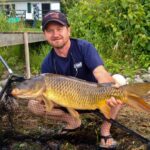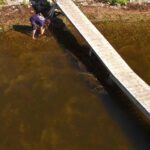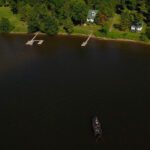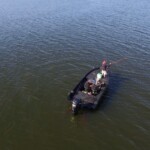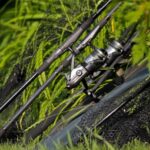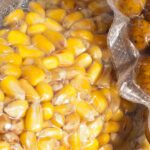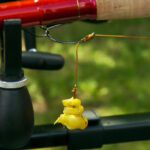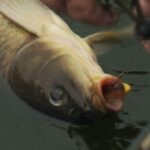This show is an eye-opener for all you anglers who have thought about Carp or, perhaps more accurately, not thought about Carp as a worthy opponent in the battle of man versus fish. Believe it or not folks, Carp are the new Bass. In Europe, they’re the new Trout.
Interestingly, here in North America, Carp were once perceived as an invasive species. In the 1870s, German Common Carp were introduced to the northeastern U.S. as replacement fish for dwindling fish stocks on the Atlantic seaboard. By the 1890s, anglers were screaming that the Carp were destroying the habitat of their beloved Largemouth. By 1910, close to 10 million pounds were harvested out of the lower Great Lakes. To say these fish are hardy and prolific is an understatement.
Ontario, and specifically the Kawarthas and the Trent-Severn Waterway, which empties into Lake Ontario, are becoming internationally known for their Carp fishing and have been attracting Carp enthusiasts from all over Europe and, in particular, the United Kingdom.
Rice Lake, although not officially a Kawartha Lake, is a prime example of not only a prime Carp lake, but a showcase of Mother Nature’s sense of balance. Remember: At one time, people in the know thought these fish were going to take over; but, to the contrary, they have become resident members of an incredible ecosystem providing habitat for Bass, Walleye, muskie, Carp, Catfish and a host of panfish.
All these species do well here. The Ministry of Natural Resources calls this lake a “fish factory”. It has the highest biomass (fish) per acre and is one of the largest and most productive inland fisheries in the province. Amazing, considering there are over 200,000 lakes in Ontario!
INFLOWS AND OUTFLOWS
Rice Lake owes its productivity to its geography and geology. It has huge inflows and outflows, and it’s very shallow. It’s about 27 feet (5m) at its deepest point, so it has great oxygenation and light. The lake is 37 km (23 miles) long and 4.8 km (3 miles) wide with abundant flats and weed beds, which are home to huge numbers of panfish.
And where you have prey fish, you have predator fish, which grow very large here. As such, professional fishing tournaments are held here every year for Largemouth and Smallmouth Bass—a testament to this productive fishery.
Throughout this episode, Pete and Ang look to see if the European style of bank-fishing is really more successful than fishing from a boat.
In Europe and the U.K., there are not a lot of boats, mostly because there’s not a lot of water. Ontario, on the other hand, with over 200,000 lakes, has water that has never seen a fisherman, let alone a boat! Avid fishermen in this country have boats because there are so many places you can go fishing. When European fishermen come here, they think they’ve died and gone to angling heaven!
That being said, these avid fishermen have made the best of their situation and have become very successful at bank-fishing. Their techniques and specialized gear are known and sold internationally. We have the fish, but they have the know-how.
CARP TECHNIQUE
The basic technique, used worldwide for catching these bruisers, is pre-baiting (or chumming) promising water, preferably the night before. This encourages Carp to gather into one area. The angler then casts a hook-bait into this area and waits for a strike. Bank-fishermen set their rods up on little stands called pods, set their strike alarms, grab a comfortable chair, have something to eat, read a book, and generally kill time until the alarm goes off. Then, typically, all hell breaks loose. Boat-fishermen, too, can set their rods in rod holders and then partake in the waiting game.
“Finding a spot that would work for both of us turned out to be really easy,” says Angelo. “How about out the back door of our cottage at Elmhirst’s Lodge, essentially right off the dock? From the shore, there’s a clear flat to about a hundred feet out, then a line of milfoil about twenty feet thick. The weedline stretches for about three hundred feet in each direction.”
Like all fish, Carp tend to hang around cover or structure of some sort for protection. So with a little chumming on the weedline, Ang and Pete would be in really good shape.
PROS AND CONS
There are both benefits and drawbacks to fishing techniques the boys use on this episode, with Pete on the shore and Ang on the boat. Pete’s using a much longer Carp-specific rod necessary for casting long distances from shore. Angelo is fishing from FNC1, Fish’n Canada’s modified Princecraft. Since Ang has a much shorter distance to cast, he’s using a regular spinning rod as well as an 8′ heavy baitcaster. They’re both using braided line because of the weeds, but everything else—the baits, rigs and the location—are the same.
ADVANTAGES
“The best thing about shore fishing is control,” says Pete. “To an extent, I’ve got some control over what the fish will do when hooked.”
For the bank-fisherman, this technique is successful for a stunningly simple reason: When you fish from shore and Carp take your bait, they swim away to deeper water for protection, and almost always set the hook themselves.
“On the other hand,” continues Pete, “the beauty of a boat is its mobility. If fishing is slow in one spot, Ang can move to another. He’s essentially got the whole lake to work. He can use electronics to find and stay on top of the fish and settle in new areas. He also doesn’t need the long rods I’m using, so he can let the Carp pull his boat halfway across the lake with whatever rod he has on hand.”
DISADVANTAGES
By fishing out of a boat, Angelo has a challenge on his hands because he won’t know which way the fish will take the hook.
“I’m fishing the other side of the weedbed and I’m casting into our chummed water,” explains Angelo. “I have to be careful because, unlike shoreline fishing, I don’t know which way to set the hook. The fish may be between FNC1 and the shore, and a hooked carp could make a bee-line right towards the boat.”
Angelo is also more affected by the weather. Finicky Carp won’t respond to a hook-bait bobbing and moving due to waves swaying the boat back and forth. He has to be extra careful when this happens. Shoreline anglers, however, don’t have as big a problem with the weather. The wind still affects the baits, just not nearly as much.
One downside to shoreline fishing is the cost of the gear—although these costs are comparatively dwarfed by the cost of a boat. But to be a successful shoreline Carp angler, you should purchase Carp specific rods, reels, pods, bite alarms, a comfortable chair… the list goes on and on and on!
All in all, the boys had a great day on the water. Pete did a little better than Angelo because it took Ang longer to pull these bruisers out of the weeds. On Ang’s strikes, the fish were running away from shore, towards the boat and into the weeds! Having a lighter rod didn’t help with that process.
Ang and Pete have both come to the same conclusion: fishing for, and catching carp, is fun! It’s a great way to experience success on and near the water.
SPECIAL THANKS




